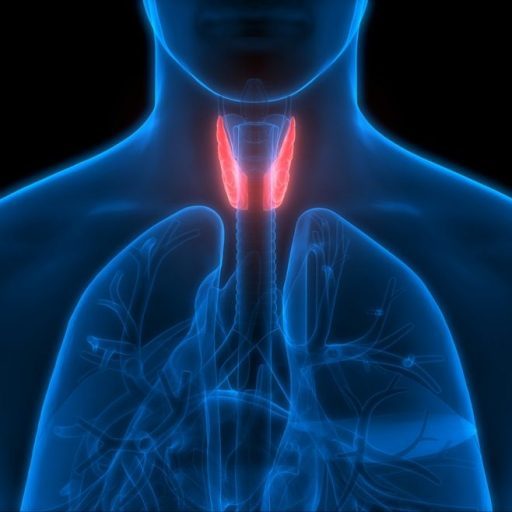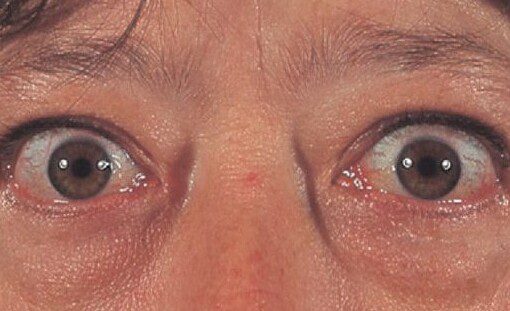Iodine deficiency is the most common cause of preventable mental retardation and brain damage in the world.
Insufficient iodine leads to a decrease in thyroid hormones that are necessary for normal growth and development. Iodine deficiency disorders (IDD) include goiter (enlarged thyroid gland), hypothyroidism, mental retardation, reproductive problems, and a wide range of neurological and physical disorders. Once dismissed as a minor, cosmetic problem, iodine deficiency disorders are now recognized as a major medical problem presenting a considerable threat to the social and economic development of many countries.
People develop IDD when there is not enough iodine in their diet. If there is little iodine in the soil, crops grown in that soil and animals grazing on that land yield insufficient iodine for the people who eat the meat and produce from these areas. This situation is more likely to be found in areas with high mountains, in geographical regions with frequent flooding, and in countries located far inland.
The Thyroid Gland and Iodine
The thyroid gland takes iodine from the bloodstream and uses it to make thyroid hormones—thyroxine (T4) and triiodothyronine (T3); the numbers four and three represent the number of atoms of iodine in each hormone. The first and most visible sign of iodine deficiency is usually endemic goiter. In cases of mild iodine deficiency, the thyroid gland can become enlarged, but thyroid hormone levels may be adequate to prevent hypothyroidism.
 However, some people living in iodine-deficient areas can also develop hypothyroidism and experience symptoms, such as fatigue, memory loss, and muscle cramps. Goiters can lead to neck and throat compression, complicating breathing. In addition, endemic goiters increase the risk of developing autonomously functioning thyroid nodules that can eventually cause hyperthyroidism.
However, some people living in iodine-deficient areas can also develop hypothyroidism and experience symptoms, such as fatigue, memory loss, and muscle cramps. Goiters can lead to neck and throat compression, complicating breathing. In addition, endemic goiters increase the risk of developing autonomously functioning thyroid nodules that can eventually cause hyperthyroidism.
By far the most significant damage of iodine deficiency is to unborn children, infants, and young children. If a pregnant mother is not consuming enough iodine, her thyroid hormone levels will be low, and she cannot provide her unborn child with the hormones necessary for normal mental development. Recent studies have indicated that even moderately low thyroid hormone levels in the mother can lower the potential intelligence of the fetus.
If thyroid hormone levels remain low during the first few months of life, the damage to the central nervous system is irreversible; thyroid hormones and iodine administered after this critical period cannot undo the damage. Iodine deficiency can also increase the risk of infant death during and soon after delivery.
The Scope of IDD
According to the International Council for the Control of Iodine Deficiency Disorders (ICCIDD), iodine deficiency disorders exist in at least 130 of the world’s 191 countries. Only twenty countries are considered to no longer have IDD, including the United States. (There is not enough information to assess forty-one countries.) The statistics associated with iodine deficiency disorder are sobering:
- 2.2 billion of the 5 billion people living in 130 countries are at risk for IDD.
- Thirteen percent of the world’s population (740 million people) have goiters.
- Until the last decade, 100,000 cretins (people suffering from severe mental and growth retardation due to IDD) were born every year.
The International Council for the Control of Iodine Deficiency Disorders’s suffering
In response to the overwhelming evidence that iodine deficiency is the leading cause of preventable mental retardation and brain damage, the 1990 United Nations World Summit for Children issued a mandate to eradicate iodine deficiency disorders by the year 2000.
 The ICCIDD is the only inter-national organization specifically organized to promote the elimination of IDD. It is a non-profit, non-governmental organization that serves as official consultant for the World Health Organization and UNICEF. ICCIDD’s multi-disciplinary network of experts comes from 82 countries. They work with inter-national agencies and governments to help them develop, implement, and monitor national programs to eliminate iodine deficiency.
The ICCIDD is the only inter-national organization specifically organized to promote the elimination of IDD. It is a non-profit, non-governmental organization that serves as official consultant for the World Health Organization and UNICEF. ICCIDD’s multi-disciplinary network of experts comes from 82 countries. They work with inter-national agencies and governments to help them develop, implement, and monitor national programs to eliminate iodine deficiency.
The Role of Salt
The body requires only small amounts of iodine; in fact, a teaspoon of iodine is all a person needs during his or her lifetime. However, since the body cannot store iodine for long periods, it is necessary to ingest tiny amounts of it regularly. Although iodine can be added to the diet in the form of iodized oil, iodized salt is the preferred way to supplement iodine in the diet for several reasons:
- Salt is universally and regularly consumed.
- It is inexpensive.
- The technology to iodize salt is simple.
- There are many studies that support the effectiveness of iodizing salt.
Potassium iodide or potassium iodate is usually used to iodize salt. These iodine deposits can be found in Chile, Japan, and the United States. Certain natural gas wells can also produce iodine. Because of the limited sources of iodine, most countries have to import it. Many countries also have to import salt.
Fortunately, the process of adding iodine to salt is relatively simple. It can even be done at the village level by spraying a solution of either potassium iodide or potassium iodate on salt as illustrated in the photograph at the top of page 3. Modern salt plants can also easily add this step in their processing of salt. Regardless of where the process takes place, the added iodine is tasteless.
Progress
Dr. Dunn says, “Fortunately, most countries now at least recognize the need to do something about IDD.” In countries where IDD is a public health problem, 68% of the population now uses iodized salt. He estimates that perhaps only twenty or thirty of the 130 countries with IDD do not have any plan, or efforts toward a plan, for eradication of iodine deficiency.
“The progress that has been made in the past decade has been remarkable.” Some of the most severely iodine-deficient areas have been the Andean countries of South America, Central Africa, the Himalayas, and the Alps. However, Dr. Dunn says “… most of these countries have made at least some effort toward correcting iodine deficiency, some quite successfully.”
The ICCIDD
The ICCIDD is unwavering in its mission. This is despite the unmet goal of elimination by 2000. Dr. Dunn has spoken on the issue. Specifically, he addressed the reasons for this failure. He said, “Causes vary across countries.” Furthermore, he stressed each case needs unique solutions. Among the factors contributing to the problem are:
- complexities in the salt trade
- poverty levels that are so dire that other priorities take precedence
- civil unrest and war
- insufficient efforts to educate government officials and the public at large of the importance of this issue
 When asked when he thought elimination of IDD will occur, Dr. Dunn pointed out that the issues are very complicated. “Some of the conditions that may lead to iodine deficiency will be present or close to the surface chronically, like crime and poverty.” For the ICCIDD’s efforts to be totally successful, the effort to eliminate IDD must be lasting. Dr. Dunn states, “Probably the single most important element in sustaining the elimination of IDD is monitoring.
When asked when he thought elimination of IDD will occur, Dr. Dunn pointed out that the issues are very complicated. “Some of the conditions that may lead to iodine deficiency will be present or close to the surface chronically, like crime and poverty.” For the ICCIDD’s efforts to be totally successful, the effort to eliminate IDD must be lasting. Dr. Dunn states, “Probably the single most important element in sustaining the elimination of IDD is monitoring.
There needs to be constant, periodic monitoring with public reporting of the results and appropriate regulatory action. The monitoring needs to include the process, usually iodizing salt, and its impact, which is best measured by urinary iodine.
Summary
Iodine deficiency disorders affect billions of people worldwide. The effects can be devastating and irreversible, not only for the people with IDD, but also their family, their community, their country, and the world. There is an effective method of elimination that is simple and inexpensive—adding iodized salt to the diet.
There is an international organization dedicated to eliminating IDD. Unfortunately, much of the public is unaware of the situation, particularly Americans. The Thyroid Society hopes that this article will be a step toward increasing awareness and support for the efforts to eliminate iodine deficiency disorders permanently.
THYROID FACTOIDS
- One-third of the world’s population is at risk for iodine deficiency disorders.
- Elimination of iodine deficiency disorders will result in the improvement of child survival rates, children’s learning potential, women’s health, quality of life, and economic productivity.
- Iodine deficiency disorders such as cretinism can be prevented but not cured.
- Long-term consumption of iodized salt is not toxic.
- Iodized salt should be used within six months of purchase.
- Iodized salt improves the health and productivity of livestock. Dairy cattle who eat iodized salt produce iodine-rich milk.
- U.S. consumption of iodine has decreased 50% over the last twenty years.
- Without appropriate monitoring, iodine deficiency disorders can recur in countries with previously successful iodization plans.
- One-third of the world’s population is at risk for iodine deficiency disorders.
EFFECT of IDD on Individuals
- Goiter
- Hypothyroidism
- Loss of energy
- Miscarriages
- Stillbirths
- Mentally retarded children
- Impaired mental and physical development
- Mental retardation
- Physical deformities
- Impaired speech and hearing
- Cretinism
- Lower productivity
- Higher demand on social services
U.S. RECOMMENDATIONS FOR IODINE INTAKE
|
Why Should We Care? When asked why Americans should be concerned about iodine deficiency disorders (IDD) in other countries, Dr. John T. Dunn, Secretary of the International Council for the Control of Iodine Deficiency Disorders (ICCIDD), listed several reasons:
- IDD existed in the U.S. until the first of the 20th century. With unregulated iodine nutrition, such as we have now, we could be faced again with problems. The lessons learned from other countries emphasize the importance of paying steady attention to our iodine nutrition
- IDD creates a large waste in terms of human potential, disease, and economic productivity. America prospers when other countries in the world—its trading partners, for example—prosper.
- It is simply uncivilized to stand by and let any people, here or abroad, suffer needlessly.
|
IODINE DEFICIENCY IN AMERICA. A THING OF THE PAST? |
|
Although there is a massive global campaign to eliminate iodine deficiency affecting one-third of the world’s population, most Americans are unaware or unconcerned about the impact of iodine deficiency in this country. Many assume that the United States has eliminated iodine deficiency and that it will not recur. But is that the case? In the early 1900s, certain areas in the United States were iodine deficient. The Midwest and Great Lakes area were known as a “goiter belt” because glaciers had stripped much of the iodine from the soil. Goiters were common, especially among women. Thyroidectomies (surgical removal of the thyroid gland) were frequent procedures. Researcher David Marine conducted clinical experiments that proved the benefits of adding iodized salt to the diet. Along with other medical leaders, Marine campaigned for iodine supplementation, particularly with iodized salt. Public health departments, medical organizations, and major salt producers joined in the cause, and, by the late 1930s, most Americans were consuming iodized salt. In contrast to Canada, the U.S. chose a voluntary iodization program. Consequently, both iodized and non-iodized salt fill store shelves. However, some Americans don’t know the difference. Surprisingly, only about half of the U.S. population uses iodized salt. Farmers in the U.S. often feed animals an iodized diet. As a result, this enhances the animals’ health and productivity. Therefore, dairy, eggs, and meat are rich in iodine. Forty years ago, bakers started using iodine in bread. Even now, some bread still contains this vital element. Besides these, kelp, certain health foods, and specific multivitamins serve as iodine sources. Indeed, these multivitamins can contain up to 150 mcg of iodine. Nonetheless, these sources aren’t strictly regulated, except for iodized salt. Both societal and commercial factors determine their iodine content. Alarmingly, iodine amounts can change without public notice. Recent studies provide some insight. On average, Americans consume about 200 mcg of iodine daily. This intake is safely above the minimum requirement. However, a recent National Health and Nutritional Examination Survey revealed a startling fact. It shows a 50% decrease in iodine consumption over the last two decades. The U.S. has managed iodine deficiency for sixty years. However, we shouldn’t grow too content. If iodine consumption trends continue to decline, our children could face increased mental impairment risks. Hence, the Thyroid Society aims to raise awareness about this potential issue. Their goal is to prevent a resurgence of iodine deficiency in the U.S. FOCUS ON RESEARCH |
Large-scale surveys occasionally evaluate U.S. health and nutrition. They’re known as the National Health and Nutritional Examination Surveys (NHANES). Thousands of Americans participate in these studies. They answer questions, get examined, and undergo various tests. All this helps identify America’s health strengths and weaknesses. Survey findings help track nutrition and illness trends. Moreover, they can detect links between food intake and disease. Hence, they inform national health and education program priorities. The third NHANES study occurred recently. It assessed American health and nutrition from 1988 to 1994. One test measured iodine in urine samples. Adults in iodine equilibrium excrete the same amount they consume. Measuring urinary iodine is simpler than measuring dietary intake. Therefore, it’s the standard test for iodine consumption studies. This NHANES study showed sufficient average iodine intake in the U.S. However, iodine deficiency needs further scrutiny. Shockingly, nearly 12% of the population had low urinary iodine levels. That’s a 4.5-fold increase compared to the first NHANES study. Almost 15% of childbearing-aged women had low iodine levels. Affluent and educated women showed even higher percentages. The reasons for these iodine intake changes remain uncertain. Perhaps reduced salt intake led to less exposure to iodized substances. Strict vegans and vegetarians might risk iodine deficiency. They avoid cow’s milk and consume food from iodine-poor soils. Ironically, following “healthier” diets could cause micronutrient deficiencies like iodine. Currently, iodine deficiency isn’t a clinical issue in the U.S. Yet, this trend is concerning and requires careful monitoring. Regrettably, the next NHANES study wasn’t designed to measure iodine. However, these studies highlight the need for increased public awareness about iodine’s importance. |








